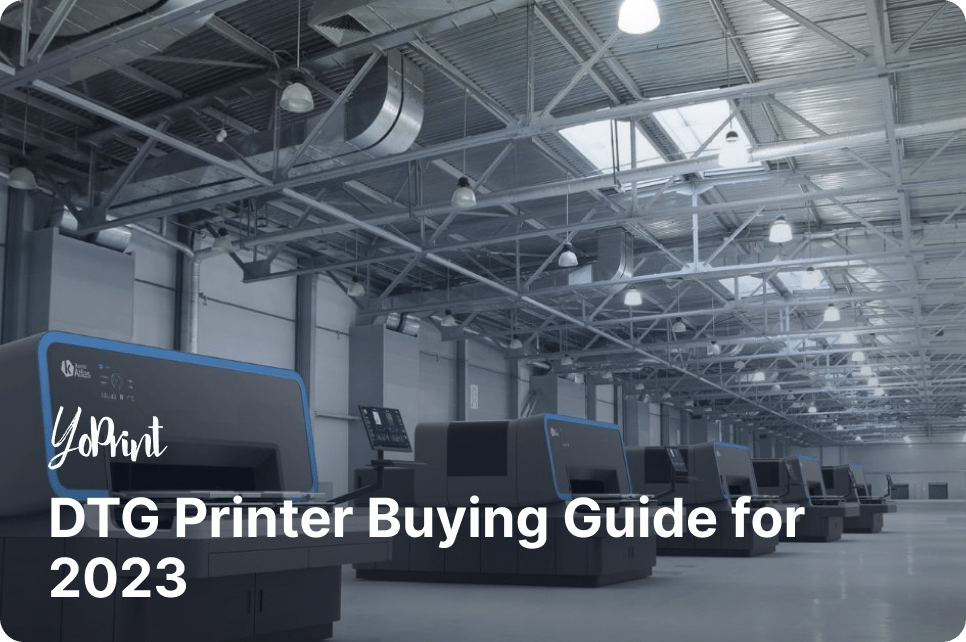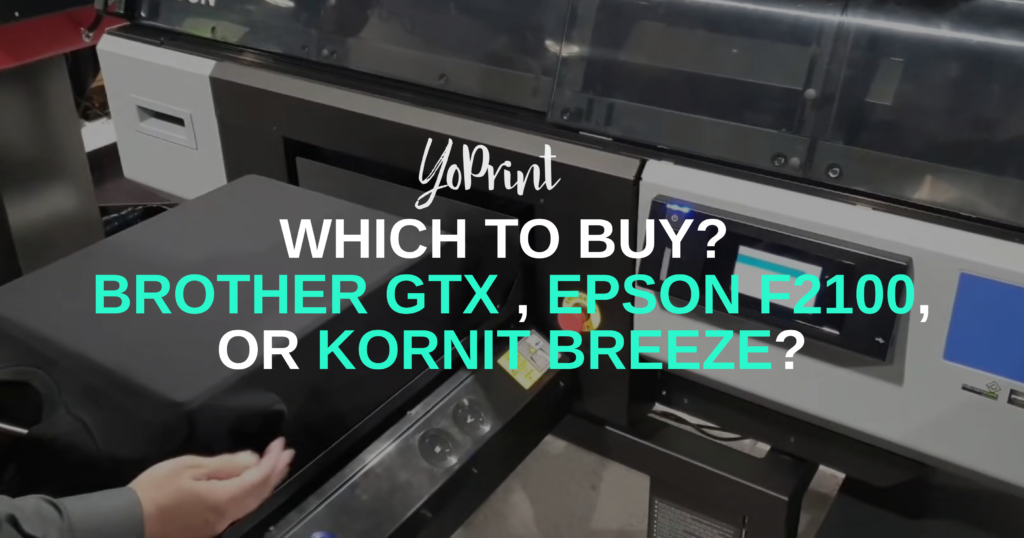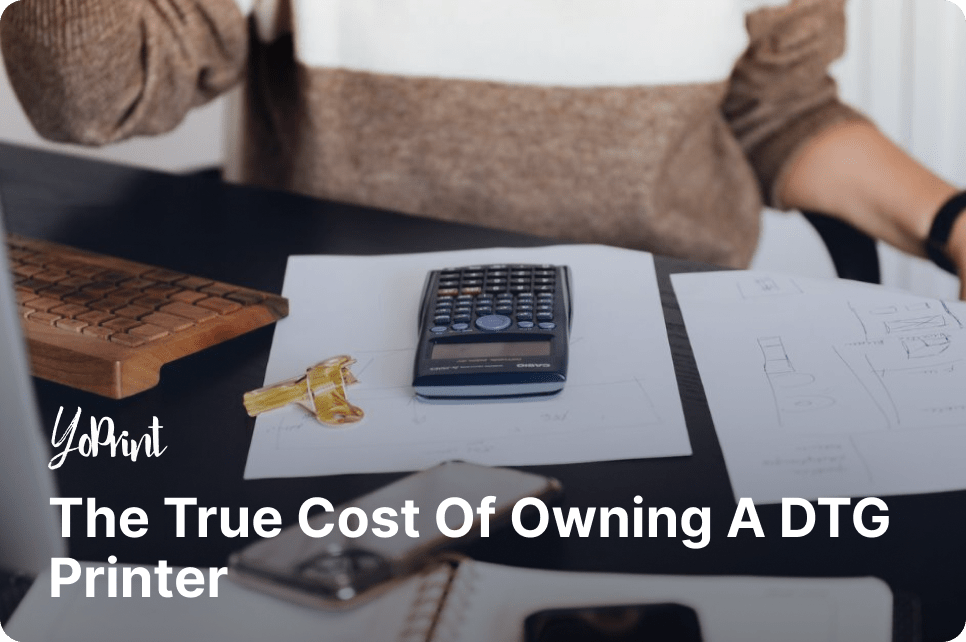There are many choices for direct-to-garment (DTG) printers available in the market. Whether you need an affordable printer within your budget range or have the means for something more powerful (like a Kornit), you’re bound to find something that suits your print shop’s needs.
Unlike buying a manual/automatic screen printing press, buying the wrong DTG machine can kill your fledgling shop before it can even open for business. DTG machines are not as universal and modular as a screen printing press, nor are they plug-and-play machines that make you money when you turn them on. As such, this guide aims to help you identify which DTG printer is the right fit for your print shop.
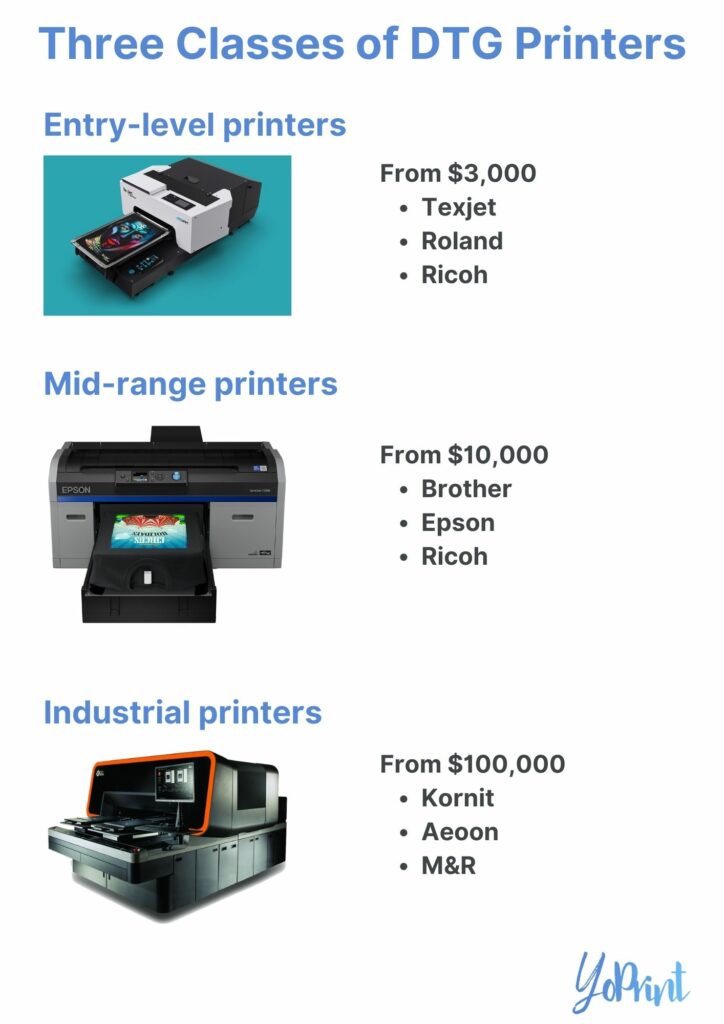
Entry-Level DTG Printers
At the height of DTG’s popularity, the most affordable way to get started with DTG printing was to buy a converted DTG printer. You’re basically buying a modified inkjet printer specifically altered for DTG printing. You could previously find them on sale from various sellers, but direct-to-film (DTF) printing’s lower entry costs and impressive print quality have overtaken the popularity of converted DTG printers. You’ll be hard-pressed to find a converted DTG printer these days.
Most of your available DTG printer options are about $5,000 or more, although you might be lucky to get one for a decent price.
Roland DG VersaSTUDIO BT-12
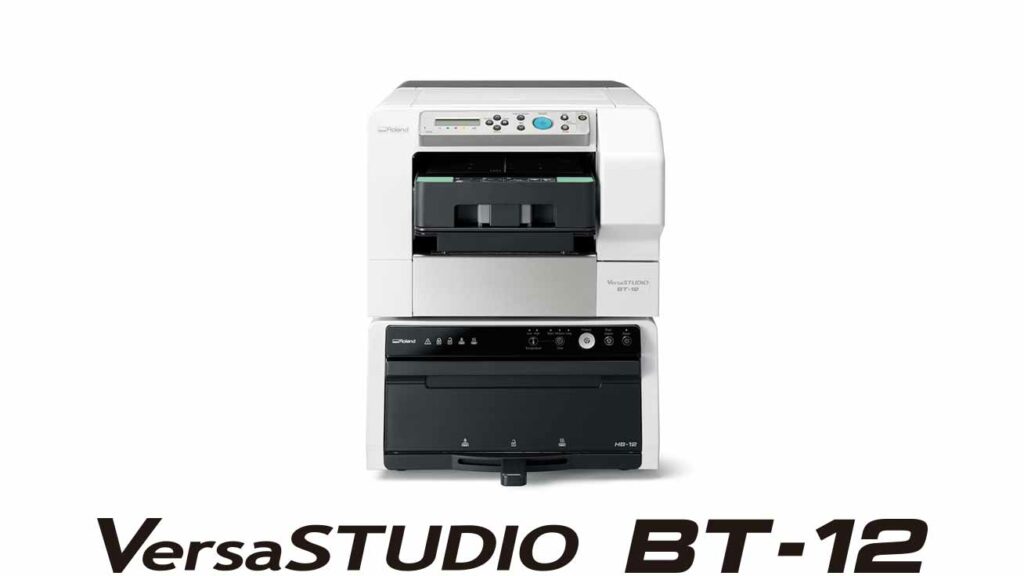
- Estimated Price: $3,495
- Pros: Very affordable, compact size, two-year warranty coverage, up to 1,200 dpi resolution, three-step printing process, safety guaranteed
- Cons: Only works on light-colored substrates, single-shirt printing only
The VersaSTUDIO BT-12 comes bundled with a printer and finisher unit in a small, compact size that fits on any table; stack them together for maximum space saving. Its printing capabilities are fully enclosed to protect you from harmful chemicals that may be released during printing. Additionally, Roland DG takes pride in building a robust, high-quality DTG printer for newcomers with a machine that’s easy to set up and bundled and easy-to-use software, durable printheads, and plenty of powerful options for your print shop.
Roland DG does offer optional accessories you can add to your printers, like additional platens of different sizes. However, they don’t offer bundle deals, so you may need to purchase these accessories separately. Given its size and limited printing capabilities, it won’t be ideal once your print shop’s business begins to take off and you get more orders in a month.
While it’s meant for light-colored garments, you can still print on slightly darker shirts with pretty good results – as long as you double up on printing them. That does mean higher ink costs, so you’ll need to consider the math of ink costs before you decide if it’s a good idea.
Ricoh Ri 100
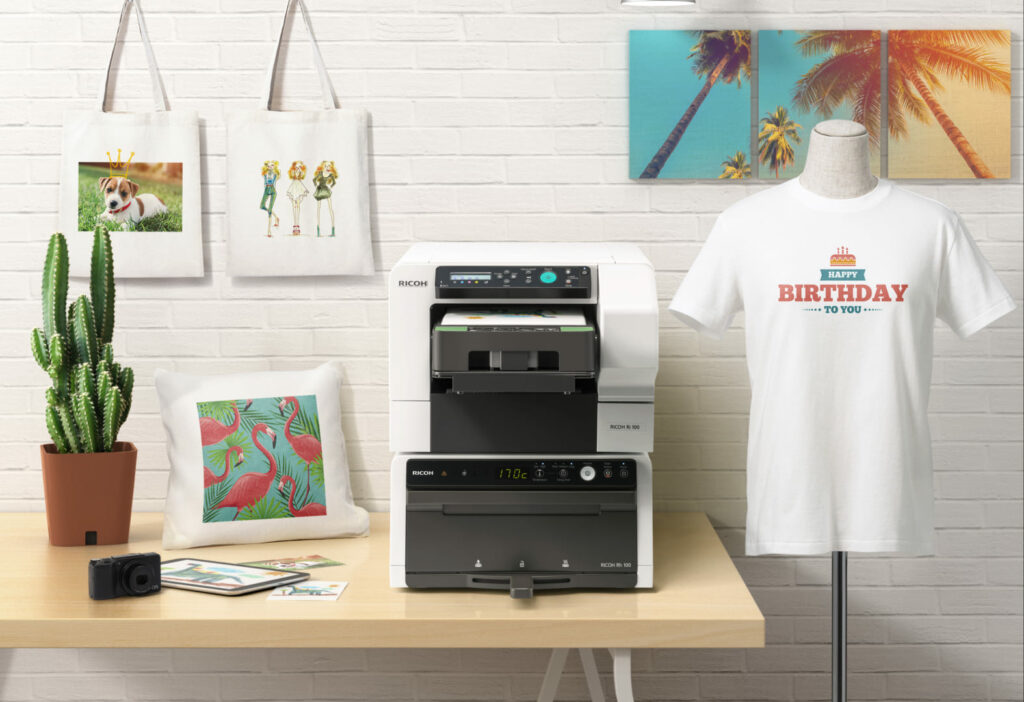
- Estimated Price: Between $4,500 to $5,000
- Pros: Relatively affordable, compact size, works on cotton and poly products, various programming functions available, two-minute printing time, up to 1,200 dpi resolution
- Cons: Only works on light-colored substrates, single-shirt printing only
The compact Ri 100 is another good choice for newcomers to DTG, with its small size and a price tag of about $4,500 or so. It features an “all-in-one design that is safe and easy to use,” while its smaller footprint (much like the BT-12) allows you to place it almost anywhere. Being easy to use is also a great bonus for newcomers still learning the ropes of DTG, allowing them to learn the intricacies of DTG printing and eventually make money from selling custom items.
You’re not limited to cotton or poly garments; you can even print designs on light tote bags. Moreover, the printer has a finisher to help “fix the ink and lock in the design;” the printer stacks nicely on top of the finisher to “maximize functionality without sacrificing space.” You can easily print high-quality images, including photographs, that will catch your customers’ attention while making a good profit thanks to the overall cost savings of the Ri 100: once you’re set-up, you can start making money.
The Ri 100 is meant to print on light-colored garments, and the double print trick with the BT-12 won’t work as well since darker substrate colors can drown out the ink colors.
PolyPrint TexJet shortee2
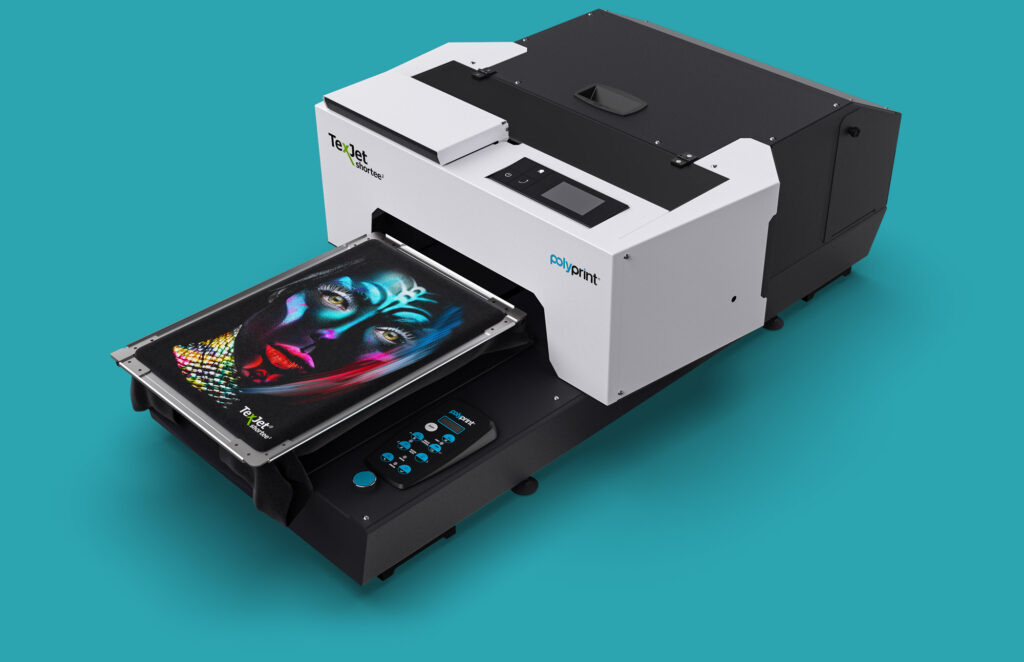
- Estimated Price: At least $9,000
- Pros: Small size, works on many substrates like cotton, denim, and even nylon, also prints on dark-colored substrates, plenty of options for various print needs, up to 1,440 dpi resolution (using CMYK +4K option), an available knowledge base for users
- Cons: Expensive for an entry-level printer, single-shirt printing only, slow printing for dark garments, requires specific inks
Greece-based PolyPrint offers the TexJet shortee2, a small entry-level DTG printer with plenty of customization options for any print shop. Though not as small as the Ri 100 or the VersaStudio BT-12, it’s still a decently compact package that can even fit in your car, allowing you to bring it along to trade shows for on-site sample printing. With an ink drop size of 3 picoliters, it boasts “scalpel-sharp detail and photo-realistic quality” for all your prints.
There’s also a built-in sensor that automatically adjusts the position of the platen before a print job is started, making it much easier to get printing without issues. Additionally, you can leave the printer on idle for up to 30 days with no ink waste or blockage, and maintenance only takes up to 5 minutes: hassle-free printing is guaranteed.
The one downside is that its dark-colored garment print speeds are pale compared to its light-colored ones: 20 per hour and 80 per hour, respectively. Additionally, the printer only accepts Power and Dupont inks; it may not be able to support compatible inks, so be warned.
Mid-range Printers
Once you’re ready to upgrade, mid-range printers offer your growing shop far more capabilities that entry-level printers lack. Once you’ve settled on a printer brand, you’ll usually stick with it until your next big upgrade, as proprietary technologies – including ink – make cross-compatibility between different printers impossible.
Epson SureColor F2100
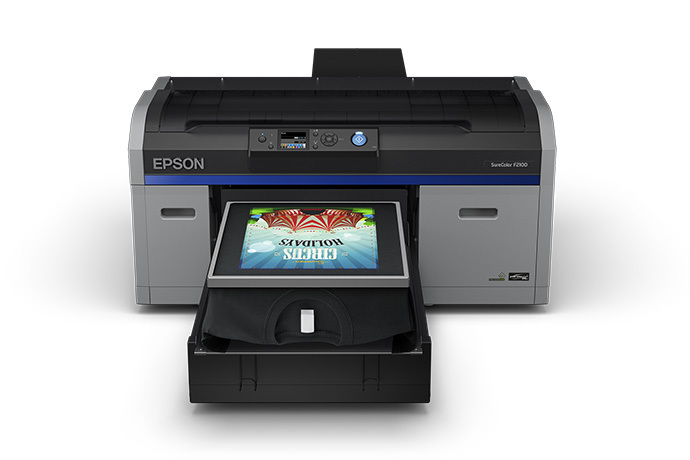
- Estimated Price: $11,995
- Pros: Decent price point, a popular brand, good reliability, up to 1,440 dpi resolution, allows quicker garment loading, great print quality
- Cons: Some accessories and consumables are pricey
The F2100 is one of the more popular mid-range DTG printers in use, alongside Brother’s GTXPro (which we’ll get to soon). With the sterling reputation of Epson, the F2100 offers a robust DTG printer with “up to twice the print speed” of their previous DTG printers. It makes use of Epson’s proprietary UltraChrome DG inks, providing prints that are “durable, vibrant, and safe” while also having vibrant colors and “equal pricing for color and White inks”
It also comes with a “Highlight White Ink mode,” which allows for simultaneous printing of white and color inks, resulting in excellent “image quality, speed, and efficiency” for your custom apparel applications. It even comes with the Epson Garment Creator Software for all your design management and cost estimation needs for every job you have.
Most users of the F2100 are happy with what it can do, especially with its versatility and ability to accept compatible inks (despite Epson recommending only using their proprietary inks) while still delivering great results. Being less maintenance intensive also helps make it a powerful asset for consistent printing.
TexJet echo2
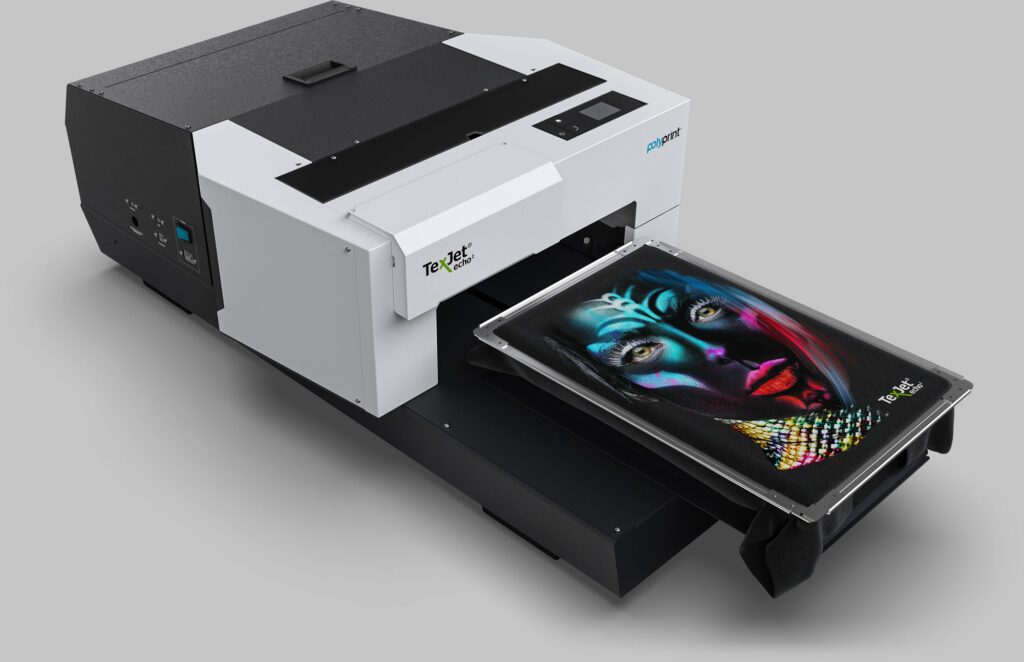
- Estimated Price: At least $12,000
- Pros: Smaller than the F2100, plenty of options for various printing needs, capable of direct-to-film (DTF) printing as well, three-year limited warranty, excellent print quality, has many of the same features as the shortee2
- Cons: Single-shirt printing only, unintuitive to use, occasionally runs into issues
The bigger brother to the shortee2, the echo2 shares many similarities with the shortee2 except for its slightly larger size, larger print area (16.1” × 23.6”), and hybrid DTG and DTF capabilities. This means you’re essentially getting a two-in-one printer for a relatively low price point, enabling you to have more substrate versatility while retaining color vibrancy. This printer is better for more established shops offering DTG prints, especially with its advanced features the shortee2 doesn’t have.
The echo2 is also designed to print on light and dark-colored garments, but some reviewers have stated its wash fastness isn’t very good. On top of that, some cite the printer as being surprisingly difficult to use, despite getting support from the manufacturers.
Ricoh Ri 2000
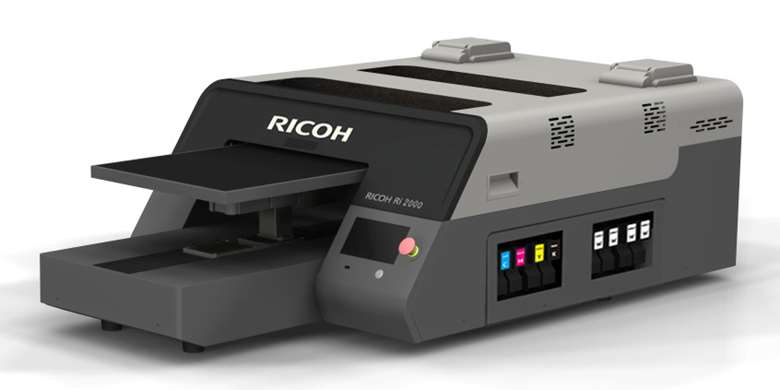
- Estimated Price: At least $13,000
- Pros: Decent price point, automated print head maintenance, built-in operation guide keeps you notified, 16″ × 19.6″ max print size, up to 1,200 dpi resolution, fast print times (especially on light garments)
- Cons: “Easy maintenance” may come with caveats, limited to cotton, cotton blends, and poly garments
Ricoh’s mid-range printer, the Ri 2000, is a step up from the entry-level Ri 100 and even their other mid-range DTG printer, the Ri 1000. Engineered to deliver “uncompromisingly high performance, innovative features, and unrivaled value,” the Ri 2000 boasts incredibly fast print speeds: less than ten seconds for light garments and under a minute for dark garments (both exclude platen loading and unloading time). The variable print speeds available ensure timely printing with top-notch results.
The Ri 2000’s “Jig Head Maintenance” automatic procedure makes it possible to quickly maintain the printheads without needing supervision, eliminating the need for messy cleanup jobs. “[A]utomated maintenance systems and advanced system monitoring” also help to ease the printing process with “smart alerts and notifications,” on top of auto height adjustments and quick-change magnetic platens for precise prints every time.
The main complaints from users stem from machine issues, including clogged ink, which arose on an infrequent basis. Some also lament the lack of deeper customer support, having to wait a long time for a reply to their complaints.
Brother GTXpro
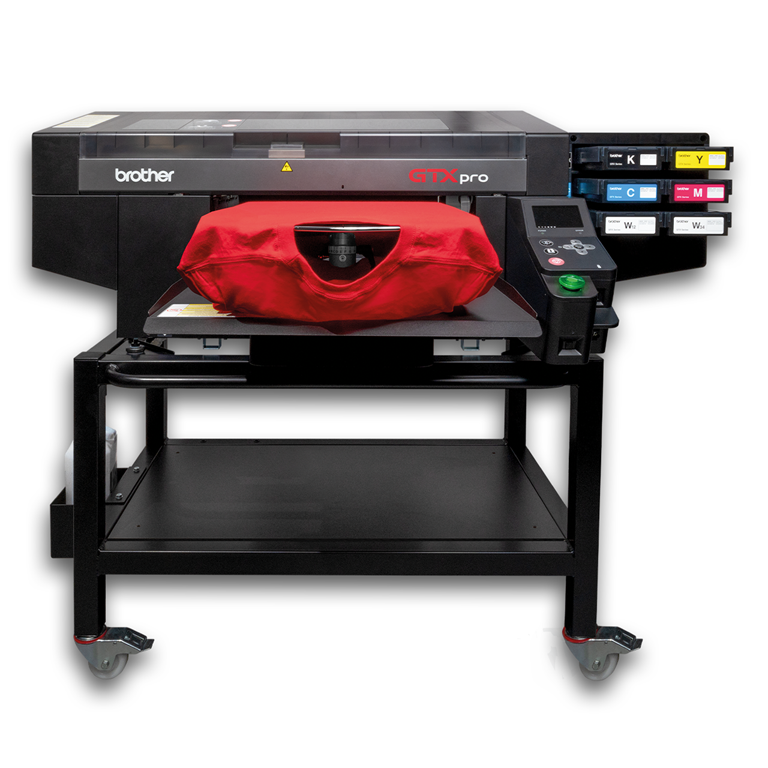
- Estimated Price: At least $19,000
- Pros: Decent price point, solid reputation, fast printing times, up to 1,200 dpi resolution, easy maintenance and printing, large print size (more flexibility and more capabilities (16” × 21”), uses safe water-based inks
- Cons: Quite pricey, “easy maintenance” may come with caveats
The GTXpro, another popular choice among DTG printers, aims to give “more flexibility and more capabilities” to custom apparel shops by providing fast and efficient printing. With a maximum print area of 16” x 21”, you can reliably print on various types of substrates easily while having a solid print output that doesn’t sacrifice overall print quality. Easy maintenance also ensures you can avoid the fear of “clogged nozzles” while ensuring the printer is ready to print anytime you need it.
Brother also makes a point to emphasize the GTXpro’s “large gap between the print head and the substrate means you can easily print over seams, across zippers and on top of pockets.” Meanwhile, its certified proprietary inks promise eco-friendly printing from start to finish, including “innovative packaging [that] uses less plastic.” Some users claim that Brother doesn’t fully use its bulk ink bags, which means wasted ink.
Epson SureColor F3070
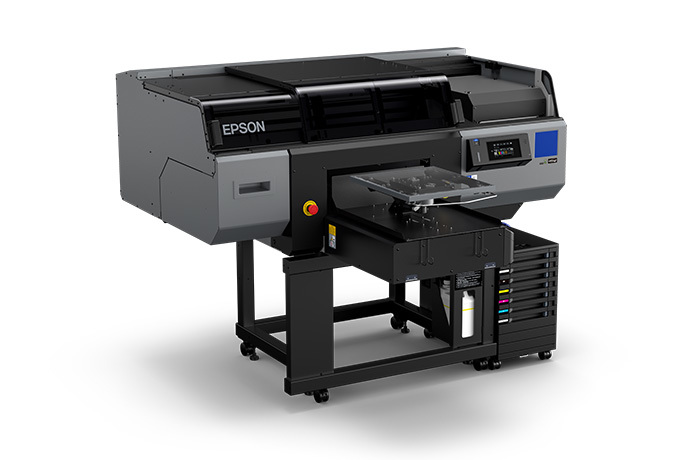
- Estimated Price: At least $49,000
- Pros: Popular brand, good reliability, fast printing times, great print quality, fast load times with quick-load platens, low maintenance downtimes
- Cons: Some accessories and consumables are pricey, only up to 1,200 dpi resolution
The F2100’s larger cousin, the F3070 promises “professional-quality, one-pass prints at industrial-level speeds.” It uses many features found in the F2100 on top of other new additions, such as the automated garment thickness detection that ensures consistent print quality on any substrate to the replaceable bulk ink system for better cost-effectiveness with ink use per job. The F3070 also has an integrated print stand allowing “easy repositioning and standard mounting points” while operating on “standard 120 V power.”
In terms of ease of use, the F3070 leads with its automatic cleaning and more efficient use of ink. The main downside might be the high cost of consumables, but other users reported that its print quality isn’t as vibrant or sharp on light garments as other competitors; wash durability is also somewhat lacking. A suggested workaround for the latter is pretreating the light garment for better results and washing fastness.
Industrial-grade Printers
These are the big guns within the industry. You’ll want to get one of these to deliver a consistently fast and robust printing service. Their high speed and amazing print quality are powerful additions to boost your print shop’s standing. While they are powerful, they are also prohibitively expensive: it would make sense to have high-volume orders to take care of, either from contract printing jobs or when working for an international clothing brand.
Kornit Storm HD6
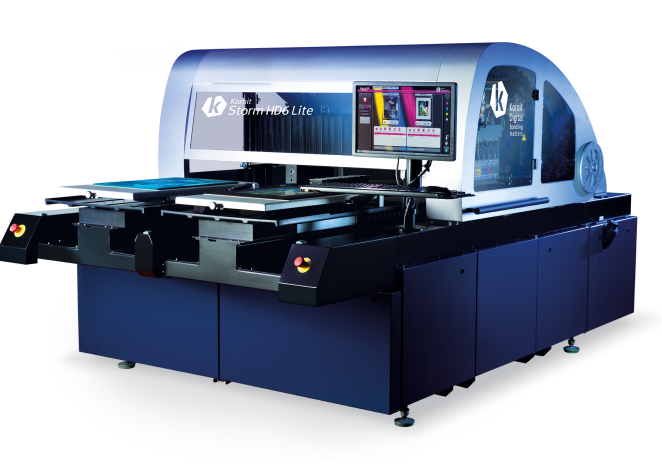
- Estimated Price: At least $300,000
- Pros: Good print output, solid print quality, print area up to 50 × 70 cm, ink recirculation system, plenty of other automation features, robust support system, various add-ons available
- Cons: Very expensive (including consumables), large footprint, might not support all kinds of substrates
Kornit is well known for its wide range of industrial printers for various applications, including textiles and upholstery. Billed as an “economical single-step solution” for DTG printing, the Storm HD6 is ideal for large print shops looking to scale up without making a hefty investment into more expensive DTG printers. Kornit claims the Storm HD6 is an ideal “profitable, single-step solution for sub-500 run lengths and one-offs” with its fast print speeds, “[s]uperior color gamut, brighter whites, and more vibrant colors” in every print.
Kornit Atlas
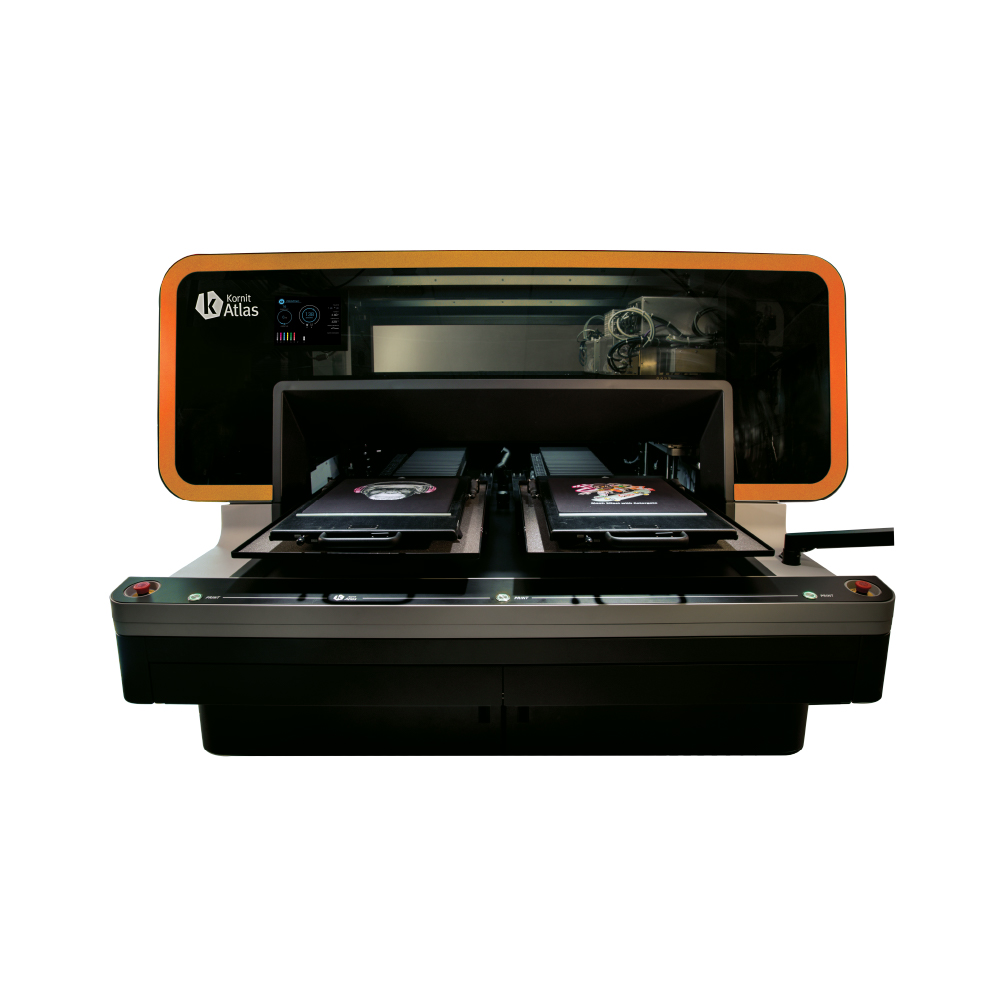
- Estimated Price: At least $600,000
- Pros: High print output, excellent print quality, prints on multiple fabrics, print area up to 90 × 60 cm, plenty of automation features, robust support system, various add-ons available
- Cons: Very expensive (including consumables), large footprint, might not support all kinds of substrates
The Atlas is one of Kornit’s more expensive options outside its top-of-the-line Atlas MAX and Atlas MAX POLY (specifically for poly-based substrates). Still, it offers plenty of utility and versatility to large print shop owners looking to do more with DTG printing. Its strengths include the superb CMYKRGB ink channel for more vibrant colors and photorealistic quality prints, as well as automatic wrinkle detection, fast print turnaround times, and exceptional quality-of-life features to make printing much easier.
Aeoon Kyo PLUS
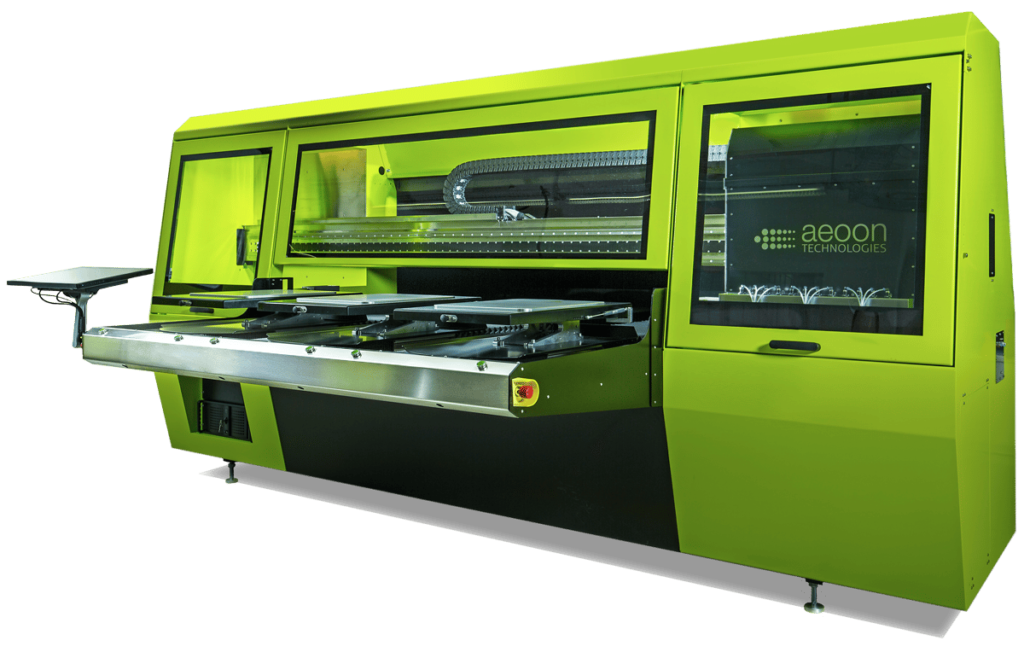
- Estimated Price: Not listed
- Pros: Prints three shirts at a time, excellent print quality, works on multiple substrates, print area up to 40 × 20 cm, built-in heat press, worldwide support, also makes supplementary equipment such as folding machines
- Cons: Very expensive (including consumables), large footprint, might not support all kinds of substrates
Aeoon is an Austrian company founded in 2011 that makes various industrial-grade DTG printers, including the Kyo PLUS. The Kyo series is said to be the “fastest DTG printer on the market,” with its ability to print 180 pieces in an hour. Its main draw is its three-platen setup, allowing users to print three shirts simultaneously from a single machine, and its quality-assured industrial print heads for excellent “high-resolution, photorealistic motifs.” The PLUS model also has integrated heat presses within its frame, enabling better wash fastness and print quality while reducing printing time.
M&R POLARIS
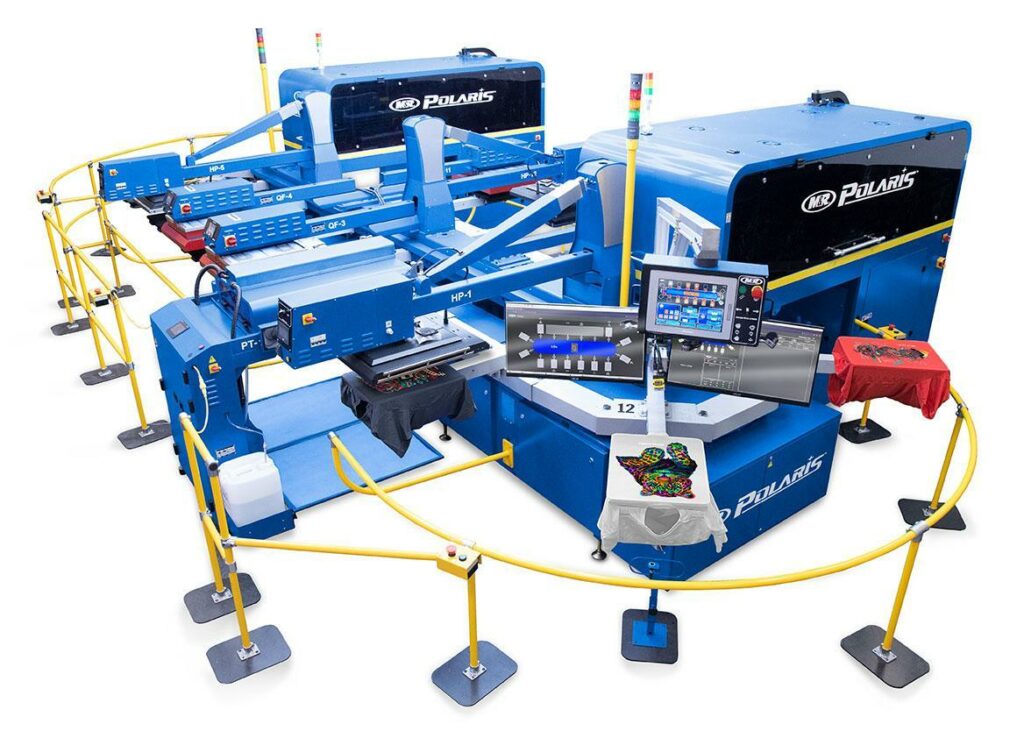
- Estimated Price: At least $800,000
- Pros: High print output, excellent print quality, prints on multiple fabrics, print area up to 90 × 60 cm, plenty of automation features, excellent support channels, various add-ons available
- Cons: Very expensive (including consumables), large footprint, might not support all kinds of substrates
M&R’s newest POLARIS system is another state-of-the-art DTG printer available for large print shops that need to meet high-volume sales. Paired with their Stryker automatic press, the POLARIS can deliver incredibly fast printing speeds thanks to its 16 stainless steel printheads with up to 1,800 dpi resolution and a maximum print area of 15” x 19”. The POLARIS also features many beneficial automation features, including digitally-controlled flashes and heat presses, precision garment placement with the laser locator system, and dual nozzle pretreatment sprays.
Conclusion
Print shops of any scale will have many choices available to them, and it’s a matter of knowing what you need now and in the future. Entry-level printers are the best and most cost-effective way to get started, but once business ramps up to 100 shirts or more being printed daily, you’ll need to upgrade to a mid-range for better print quality, faster turnaround times for orders and the ability to keep up with demand. Once your business is making huge gains with orders going above 500, industrial DTG printers are the next step to scale and meet your high-volume quotas.
Make sure you do your own research before purchasing: information is a powerful asset to know what will work best for your print shop.
